 |
|

|
 |
TABLE of CONTENTS
|
Toward Zero Deaths celebrates accomplishments at annual conference, looks to future |
By Sue Roe
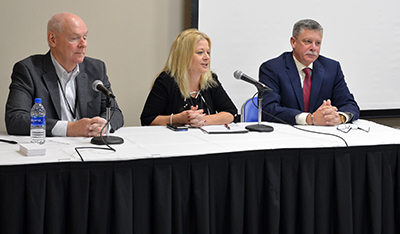
Peter Buchen, Office of Traffic Engineering; Kristine Hernandez, TZD statewide coordinator; and Mike Hanson, TZD program co-chair, Minnesota Department of Public Safety; hold a listening session at the TZD conference to discuss the future of the program. Photo by Sue Roe |
Transportation safety professionals celebrated 15 years of the Toward Zero Deaths program at the annual conference in Mankato Oct. 23-24. About 1,000 people attended from organizations representing education, emergency medical and trauma services, enforcement and engineering. The conference is the largest traffic safety conference in the country, sharing best practices and new approaches to reducing traffic fatalities.
“What sets us apart from other states is that we collaborate,” Commissioner Charlie Zelle told the audience during the awards ceremony. “We have much to be proud of and much left to do to drive the number of casualties down to zero. It can’t be done alone.”
Key speakers for the conference were Andy Stumpf, retired Navy SEAL, and Ellie Wilson, executive director of the Autism Society of Minnesota.
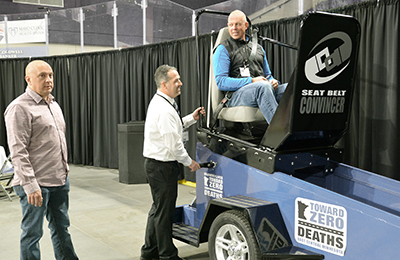
Tom Nixon (center), East Central Regional Toward Zero Death coordinator, helps Craig Honkola, health and safety manager at Northeast Service Cooperative, Duluth, use the seat belt convincer during the TZD state conference in Mankato Oct. 23-24. Deric Swenson, Moorhead Police Department, is on the left. The convincer gives riders the experience of the impact of hitting a vehicle at 5 to 7 miles per hour. Photo by Sue Roe |
Stumpf talked about what it takes to be a good leader and teammate. He said successful leaders focus on accountability, responsibility, humility, trust, empowerment and being calm under fire. He said these and other leadership traits, which are prevalent in SEAL teams, can help Minnesota stakeholders drive the fatality and injury crash rates toward zero.
Wilson talked about the behaviors associated with autism and similar disabilities and how emergency response teams can use effective and practical strategies to improve communication, assessment and behavior. Autism Spectrum Disorders now occur with a prevalence of one in 59 individuals in the U.S., which is even higher in Minnesota.
Ten awards were given to individuals and organizations that have improved traffic safety throughout the state. The Kathy Swanson Outstanding Service Award was given to Mark Peterson, current public affairs specialist for AAA, who previously worked for 25 years for the Minnesota State Patrol as a patrolman, field supervisor and training academy director.
Other award winners were:
- Child Passenger Safety Star Award – Karri Hendrickson, Maple Grove
- Distinguished Public Leadership Award – Lisa Kons, Cottage Grove
- Enforcement Star Award – Kevin Otto, Maplewood
- Emergency and Trauma Services Star Award – Amy Saylor, Hill City
- Engineering Star Award – Richard Sanders, Crookston
- Judicial and Court System Star Award – Abby Kuschel, Grand Rapids
- Education Award – Jeff Strom, Albert Lea
- Traffic Innovation Award – Bemidji Area Schools
- Special Award of Recognition – Emily Steffens, Dodge Center
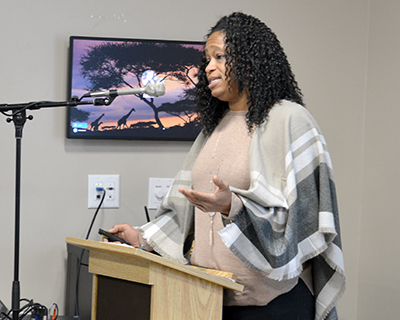
Cherzon Riley, transportation specialist at Metro District, presents information about work zone safety during the annual Toward Zero Deaths state conference in Mankato Oct. 23-24. Photo by Sue Roe |
Since TZD’s start in 2003, the number of traffic deaths declined 45 percent, from 655 in 2003 to 358 in 2017. Overall, fatalities in the state are on a downward trend. Traffic fatalities averaged 614 a year from 2000 to 2004. The average from 2013 to 2017 was 382.
MnDOT employees presenting at the conference included:
- Jacob Reuter, Office of Transit and Active Transportation, and Derek Leuer, Office of Traffic Engineering, talked about strategies to keeping pedestrians safe on the roads. Leuer also spoke in a second session about the updated crash report and how engineers use the data to make roadway improvements.
- Cherzon Riley, Metro District, and Ken Johnson, Office of Traffic Engineering, talked about work zone safety.
- Anne Meyer, District 6 Public Affairs, spoke on a panel about what to expect in media interviews and how to prepare for them.
- Eric Peterson, Metro District, presented information about new roadway requirements and roadway safety plans, which assess roadways to identify potential candidates for proactive measures.
- Brad Estochen, Office of Traffic Engineering, talked about the challenges of traffic engineering, facts versus misconceptions about safety, and the results of MnDOT’s trunk highway evaluations for roadways being converted from 55 mph to 60 mph.
- John McClellan, Regional Transportation Management Center, spoke about traffic incident management training as a safe and effective traffic control at roadway incidents, such as crashes and fires.
- Peter Buchen, Office of Traffic Engineering, and Kristine Hernandez, statewide TZD coordinator, held a listening session about how to build on the successes of TZD to make it an even stronger program.
|
 |
|

|
 |
TABLE of CONTENTS
 |
MnDOT launches first community solar garden project |
By Sue Roe

This is one of the panels that will go on Ramp A as part of the solar garden project. The 40 by 80 inch panels will provide enough electricity to supply up to 180 households. The solar garden is the first to be built on MnDOT right of way. Photo by Sue Roe |
MnDOT and Cooperative Energy Futures launched a new community solar garden project in downtown Minneapolis Oct. 29. The solar garden will be built over the top level of the MnDOT-owned parking Ramp A. The city of Minneapolis manages the ramp.
This is MnDOT’s first solar project in the agency’s right of way and first solar garden subscription. It advances Gov. Mark Dayton’s executive order for state agencies to support renewable energy.
Cooperative Energy Futures has been building its community solar model since 2013. It is a Minneapolis-based, member-owned energy services cooperative that creates energy efficiency and clean energy solutions.
“Community solar gardens will reduce energy costs for participating households and businesses,” said Commissioner Charlie Zelle. “We are happy to partner with Cooperative Energy Futures to commercially develop the agency’s right of way into something that will reduce carbon emissions.”
A solar garden is a large array of solar panels that generate electricity from sunlight. The garden will provide a cover over half of the Ramp A parking deck. No parking spaces will be lost. Construction is expected to start in spring 2019 and be completed by fall 2019.
Cooperative Energy Futures leased the ramp space from MnDOT for 25 years.
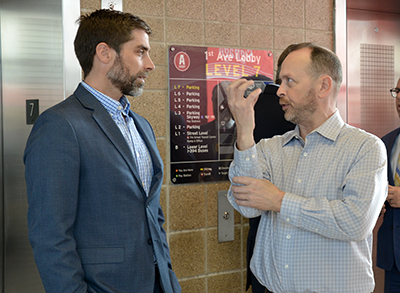
Tim Sexton, left, MnDOT sustainability director, talks with Bruce Konewko, solar operations and marketing director from Cooperative Energy Futures during the project launch of the solar garden on Ramp A. Photo by Sue Roe |
“For MnDOT, it is an opportunity to contribute to the health of the state’s environment,” said Zelle. “It allows us to provide a currently unused space to create energy. We are always looking for ways to improve our stewardship of the environment in which we work and to work with partners to better our operations.”
Similar to a community garden where each person has a plot of land, CEF will sell solar garden subscriptions to subscribers who will receive credits on their electric bills for the electricity produced by their portion of the solar garden’s production. This program provides a way for people to access renewable energy that is not directly connected to their electrical meter.
Eighty percent of the subscriptions will be sold to residential households, primarily in Minneapolis, including low- to moderate-income residents and those in affordable housing. MnDOT will be a backup subscriber and receive bill credits for at least 20 percent of the subscriptions’ solar array production.
“As transportation continues to grow and evolve, we believe that we need to think harder and be creative in how we treat and use right of way. This project is a great example of a use that will benefit Minnesotans for years to come with clean, efficient energy,” said Zelle. |
 |
|

|
 |
TABLE of CONTENTS
 |
Thomas Bredemus eligible for vacation donation |
|
Thomas Bredemus, Statewide Radio System Radio Operations Center, is eligible for the vacation donation program. Bredemus has worked for MnDOT for six years.
He was diagnosed with a non-traumatic intracranial hemorrhage in May and it is a life threatening situation. The Vacation Donation program will help with his ongoing rehabilitation and recovery time.
Also eligible for the vacation donation program are MnDOT employees Donna Koren, Operations Division; Tom Brown, transportation generalist in District 2; Donald Obernolte, Office of Environmental Stewardship; Patty Johnson, District 3 maintenance; Kyle Goosman, District 8 transportation generalist senior; Racheal Glancy, Project Delivery Division; and Melissa Janzen, Office of Land Management.
To donate vacation hours, go to the Employee Self Service Web site and click “Other Payroll” and then “Leave Donations.” The site also allows employees to view a list of all state employees eligible for the program and to enroll as a recipient. |
 |
|

|
 |
TABLE of CONTENTS
 |
Information Governance is important to the agency |
By Angela Boardman, Office of Chief Counsel
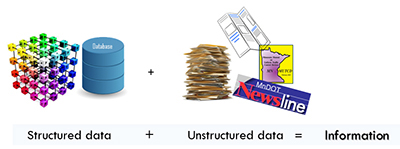
It is important for MnDOT employees to manage structured data and unstructured data responsibly and consistently. |
Data governance is not a new concept at MnDOT. Formal data governance initiatives have been around at the agency since 2008. Over the past 10 years, much has been said and learned about data governance. It’s about treating data as assets and managing those assets responsibly, in accordance with generally accepted principles like availability, compliance, and integrity. Although data governance is a highly recognized phrase, information governance more accurately conveys the scope of asset management for which the agency is responsible.
Structured data, like the kind that reside in electronic systems, are easily searchable and can be aggregated and analyzed to produce insights and inform decisions. Unstructured data (or unstructured information), like contracts, maps, email, and audio or video files, are often overlooked when people hear data governance. This doesn’t mean that we have to stop saying “data” and start using “information” exclusively; it’s just a reminder to be aware of the breadth of content—information assets—we have to govern.
It’s not just “an IT thing.”
Gartner defines information governance as “an accountability framework” for ensuring “effective and efficient use of information in enabling an organization to achieve its goals.” This definition establishes IG as an agency-wide business imperative. It includes structures, roles, policies and processes for managing information consistently, at all levels.
Whether called data governance or information governance, the framework exists to help employees do their job better and manage state assets effectively.
For more information or to request training, check out the information governance webite.
|
 |
|

|
 |
TABLE of CONTENTS
 |
Statewide Minnesota government employees' survey seeks to improve workplace |
|
By Mary McFarland Brooks

|
Earlier this month Minnesota Management and Budget announced the first-ever engagement survey of executive branch employees. The goal of the survey is to use the results to support a world-class workforce and respectful workplace.
The survey results will guide agencies in recruitment, development and retention of the state’s greatest asset – employees. The survey’s purpose is to learn what employees currently think about their work environment, what is going well and where improvement is needed.
The survey will also provide baseline data to measure future progress. Each agency, including MnDOT, will receive agency survey results to use in making changes to work environment and documenting important observations.
The survey launched in mid-October, and because of the nearly 35,000 employees involved, is being rolled out in phases. The survey closes for everyone Nov. 21.
Employees with a state email address will have received a survey invitation in their work email inbox by now. Employees without an email address will have received a postcard in the mail at their work location, inviting them to take the survey during work time, preferably on a work device. The survey takes about 10 minutes to complete. If you have not received an email or a postcard inviting you to participate in the survey, please contact MnDOT’s engagement champion, Linda Hinrichs (contact information below).
The survey is anonymous and results will not be attributed to specific individuals.
The following resources for the Enterprise survey are available for employees:
If you have further questions, contact Linda Hinrichs at 651-366-5244 or linda.hinrichs@state.mn.us.
The survey results will be available early next year. |
 |
|

|
 |
TABLE of CONTENTS
 |
What's new on the web |
By Kelsey Baumann, Human Resourses
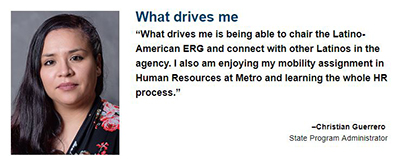
The 'What drives me?" section of the Careers website highlights employees and what drives them to work for the agency. |
New Careers website
The MnDOT Jobs website, has been replaced by a new Careers site, which has been designed to provide both internal and external job seekers with information on MnDOT career paths, application and job search tips, and insights into what it’s like to work at MnDOT.
Want to learn more about MnDOT Careers, check out these new sections:
- Students and grads: Learn about the different programs, and see the path from student to career
- Professionals: Dozens of different MnDOT career paths are highlighted here; find out, for example, what hydrologists (and other professions) do
- Technicians: Showcases the transportation specialist series
- Benefits: See the whole suite of benefits for State Employees
- Diversity: Highlights all of the ways that MnDOT works to be a diverse and inclusive employer; learn about a variety of resources and programs available
- How to Apply: Get the inside scoop on how to apply, and how to be successful in applying, for MnDOT jobs
|
 |
|

|
 |
TABLE of CONTENTS
 |
Election will lead to changes at MnDOT |
By Sue Muvihill, deputy commissioner and chief engineer
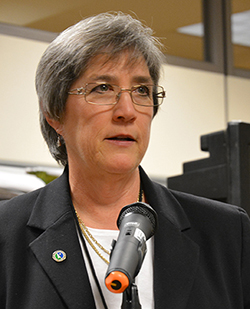
Sue Muvihill is MnDOTís deputy commissioner and chief engineer. Photo by Rich Kemp |
On Nov. 6, voters in the state of Minnesota will elect a new governor who will take the reins from current Gov. Mark Dayton. Commissioner Charlie Zelle has indicated that when Gov. Dayton leaves his post, he will also leave MnDOT.
The new governor will assume the job on Jan. 7. In all likelihood, a new commissioner will be named shortly thereafter, and will assume the new job at a negotiated time with the governor. Until the new commissioner joins MnDOT, the governor will probably name an interim commissioner.
Transitions are a standard part of the cycle of state government. Right now, a committee of senior MnDOT leaders are preparing a set of documents to assist the new governor and the new commissioner. These documents will describe the agency, our funding and project status, list issues and initiatives, and provide other detail that a new administration will need to familiarize itself with MnDOT as it begins running state government.
While this information will be new to an incoming governor and commissioner, it is not something we have created just for this purpose. It is all available in various places on the MnDOT website.
State government is intended to continue operating at a high level through these types of transitions. The citizens of this great state expect that and it’s no different for MnDOT. We will continue our work as we have in the past and will use the current vision, mission, guiding principles and the Strategic Operations Plan as our map. At some point a new administration may make changes, but until then we will continue on as we have.
For those of us who have been through a transition period a time or two, there may not be a great deal of concern. However, for some there may be some questions. To that end, you can find a comment/question form at this link: http://ihub/transition2018.html.
You can ask questions there anonymously, or request that an answer be sent to you specifically. The Office of Communications will gather questions that come in, post the questions, identify trend questions, and post answers once a week on that site.
I appreciate your strong dedication and professionalism and I know that those attributes will help you negotiate this transition. Transportation is a key to the state’s economy and to the high quality of life we enjoy in this state. Minnesota has a very good transportation system that operates at a high level of efficiency and effectiveness because of the hard work you all do!
On behalf of all Minnesotans, I thank you for your hard work and dedication. From me personally, I am extremely proud to say that I work with all of you and for this great agency.
|
 |
|
| |
|



